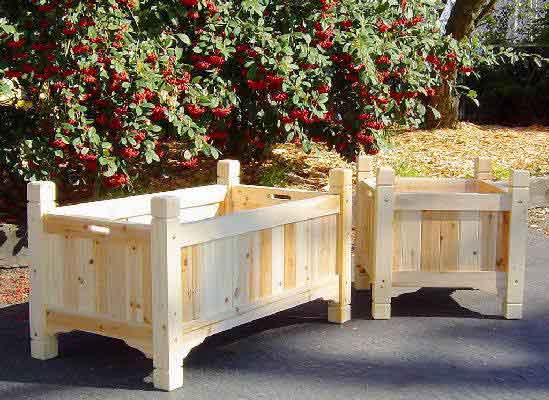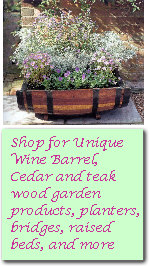 Cedar Planter Containers
Cedar Planter Containers
There are so many lovely plant containers and pots available
for use in our gardens, on decks and porches and indoors. How do you choose
the best one? Too often we are guided by our taste alone. However to keep your
container gardens growing happy and healthy you should give some consideration
to the plant's needs when choosing a planter. Some things are common sense,
like ensuring your planter has drainage holes. Here are some other things to
think about:
There are three basic questions when selecting a container,
but after those questions are answered, your only limit is your imagination.
Be Sure Plant Can Live
First, will the plants live? To ensure success, make sure
there is:
 | good drainage provided by plenty of holes in the bottom
of the container and no drain dish to hold water around the plant roots;
|
 | sufficient root space for the plant to grow as large as
you want it to. The same tree could be a bonsai in a 2-inch pot, a patio
decoration in a 10-gallon container, or a shade tree in a 200-gallon
container. Generally you would need a planter with capacity two times the
size of the root ball of the plant you intend to plant.
|
 | enough weight to provide support to the plant. It is most
distressing to find a prized plant sprawled across the deck days before all
the flowers were to open. Many of today's containers are made of plastic,
and when used with synthetic soil mixes, they are very light. If your plants
will get top heavy, consider adding a few stones or a brick to the bottom of
the container before planting. |
Plant Selection
We often leave the choice of plants to the very end of
creating a container garden. It's not crucial that you know ahead of time
exactly what plant you plan to use in your container garden, but you do need
to consider a couple of key facts when deciding on a planter.
- Can the plant survive in dry conditions?
- What is the mature size of the plant you've chosen? Be
sure you've chosen a pot that is big enough for the plant's root ball as it
grows.
Exposure
Will the
container be exposed to the hot mid-day sun? Will it be in full sun all day?
How about strong breezes? We've already mentioned that all pots dry out faster
than soil in the garden, but certain exposures will exacerbate the situation.
If you are planting in full sun, you will probably want a pot made from
material that is not porous. Terra cotta dries out very quickly. Synthetic
resin pots stay cooler and retain moisture longer
Watering
Is someone able
to water everyday? If not, does the pot or container have a drip tray or a
reservoir so that it can be filled from the bottom and soak up water as
needed? Once a plant has been stressed from lack of water, it may never
recover
Winter
Will you be leaving the planter out through the winter? In
USDA Zones 7 and above, this usually won't make a difference. Colder climates
will need to choose frost safe containers like stone, cement and wood.
Mobility
Do you need to
move the pot around? Sometimes a planter on a deck needs to be moved for
convenience. Maybe you want the ability to move your container garden where
the sun or shade is or you plan on taking the container in for the winter. If
you need the ability to move the pot for any reason, think twice about buying
either a heavy or cumbersomely large planter. You may also buy a
planter dolly to move your planter around. Concrete urns are gorgeous, but
they should stay where you put them so as not to break either your back or the
urn.
Materials - Clay & Stone
Cedar wood: Cedar is naturally rot resistant in outdoor,
they are natural looking, Cedar Planter
Containers and the log wood planter is the best choice for container planting if you live in the
city, they are light weight. Bamboo planter
and willow planter are made of rapidly renewable material also make
great looking planter, except they do not last as long as the cedar wood
planters. Terra cotta: Traditional, but porous and dries out quickly. Many are
not frost-resistant. If it was made in a warm area, like the Mediterranean,
it's probably not. ------ Stone and Concrete: Both are good for maintaining
soil temperature and moisture. They heat up, but also insulate. Both can be
left out over winter, but not great choices if the planter needs to be moved.
Great if you need a planter the dogs can't knock over.
Materials - Synthetic
Fiberglass and resin: Synthetic pots have come a long way.
Many can easily fool the eye into thinking they are a natural material,
especially as they age. They are light, durable, inexpensive and often
frost-resistant. ------ Plastic: Lightweight and moisture conserving. The
semi-flexible pots work best for cold winters and are also good as liners.
Plant directly into the plastic pot and then slip the plastic pot into the
more decorative container. You get the benefits of both.
![]() Gardeners' Corner
Kids'
Garden
Sustainable Garden
Contact Us
Gardeners' Corner
Kids'
Garden
Sustainable Garden
Contact Us![]()


